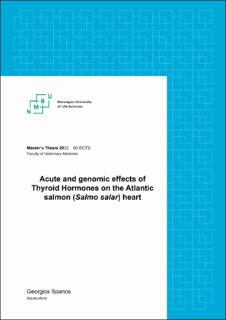| dc.contributor.advisor | Frisk, Michael | |
| dc.contributor.advisor | Vindas, Marco | |
| dc.contributor.advisor | Hodne, Kjetil | |
| dc.contributor.advisor | Johansen, Ida Beitnes | |
| dc.contributor.author | Spanos, Georgios | |
| dc.date.accessioned | 2022-09-27T10:51:29Z | |
| dc.date.available | 2022-09-27T10:51:29Z | |
| dc.date.issued | 2022 | |
| dc.identifier.uri | https://hdl.handle.net/11250/3021723 | |
| dc.description.abstract | Farmed salmon suffer from a variety of heart pathologies that impair cardiac function and ultimately contribute to cardiac failure and mortality. Thyroid hormones (TH) have well-studied cardioprotective effects in mammals, through direct, genomic and non-genomic (acute) actions. TH enhance cardiac activity and promote physiological cardiac remodeling while they are an important regulator of Ca+2 transients of the cardiomyocyte. TH peak during critical events of salmon life cycle with increased cardiac demand (e.g., smoltification), but their role in cardiac physiology in Atlantic salmon (Salmo salar) remain largely unknown. The aim of the current study was to investigate whether TH have direct acute and genomic effects on Ca+2 dynamics in the salmon heart. To investigate acute effects, salmon ventricular cardiomyocytes were isolated using a standard enzymatic technique, while Ca+2 transients were recorded in the presence of different concentrations of the TH, 3,3’,5-Triiodo-L-thyroinine (T3). To investigate genomic effects, whole hearts were incubated under different concentration of T3 and the expression of genes encoding proteins related to Ca+2 cycling and hypertrophy was quantified by qPCR. Stimulation with T3 acutely decreased the time of half removal and increased the Ca+2 extrusion rate of the Ca+2 transient. These findings are largely in line with the observed acute effects of T3 on mammalian cardiomyocytes and could help the heart to work effectively when the heart rate is elevated. Further investigation is required to understand the underlying physiological mechanisms. The study did not reveal any genomic effects of TH on the salmon heart. Although these findings partially agree with previous findings in other teleost fish but limiting factors of our study do not allow us to exclude genomic effects of TH on the salmon heart. Nevertheless, the results indicate that TH could have a cardioprotective role also in salmon, for example in contexts that increase cardiac demand, such as during smoltification. | en_US |
| dc.language.iso | eng | en_US |
| dc.publisher | Norwegian University of Life Sciences, Ås | en_US |
| dc.rights | Attribution-NonCommercial-NoDerivatives 4.0 Internasjonal | * |
| dc.rights | Attribution-NonCommercial-NoDerivatives 4.0 Internasjonal | * |
| dc.rights.uri | http://creativecommons.org/licenses/by-nc-nd/4.0/deed.no | * |
| dc.subject | Atlantic salmon | en_US |
| dc.subject | Ca+2 cycling | en_US |
| dc.subject | Thyroid hormones | en_US |
| dc.subject | heart | en_US |
| dc.subject | cardiomyocyte | en_US |
| dc.title | Acute and genomic effects of Thyroid Hormones on the Atlantic salmon (Salmo salar) heart | en_US |
| dc.type | Master thesis | en_US |
| dc.subject.nsi | VDP::Agriculture and fishery disciplines: 900 | en_US |
| dc.subject.nsi | VDP::Medical disciplines: 700 | en_US |
| dc.description.localcode | M-AA | en_US |

